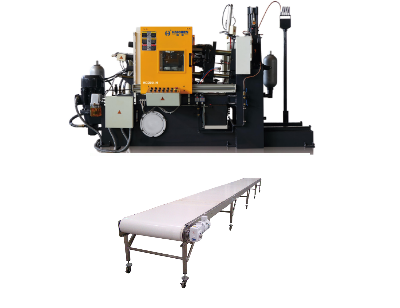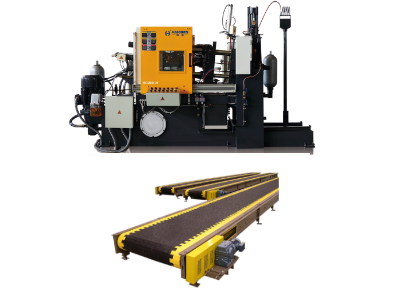For die casting machines, scrap conveyor belts offer the following advantages:
- Increased efficiency and automation
- Enhanced logistics management
- Reduced energy consumption and maintenance costs
- Improved reliability and durability
- Adapt to a variety of working environments
- Environmental protection and safety
- Space-saving and improved product quality
- Space saving
- Product quality improvement
- Energy Advantages of scrap conveyor Systems
Scrap conveyor belts for die casting machines provide important support for die casting production by increasing efficiency.
Reducing energy consumption, enhancing reliability, and adapting to a wide range of working environments.
Conveyor belts can turn a laborious task into a breeze; they help keep things moving in places where traditional conveyors cannot reach.
This flexibility allows businesses in various sectors to increase efficiency and reduce manual labor significantly.

Increased efficiency and automation
Scrap conveyor belts for die casting machines allow for intermittent and continuous operation.
In the traditional scrap transfer method, the transfer with a conveyor is inefficient and difficult to achieve continuous operation.
Conveyor belts are able to meet these needs, resulting in higher efficiency.
Enhanced logistics management
Conveyor belt systems typically use apron, chain, or belt conveyors to transport scrap to the appropriate unloading point.
This system is also stable at low speeds, has no “creeping” phenomenon, and is suitable for the transportation of various materials.
Reduced energy consumption and maintenance costs
Scrap conveyor belts for die casting machines are often designed with energy and maintenance costs optimized in mind.
For example, by improving the dynamics of the chain drive system, impact stresses and load deformations at start-up can be reduced, resulting in lower energy consumption and longer equipment life.

Improved reliability and durability
The scrap conveyor belt of the die casting machine has high reliability and stability during transportation.
Such as the scraper and chain, which is durable and not easy to damage.

Adapt to a variety of working environments
The waste conveyor belt of the die-casting machine is not only suitable for normal temperature environment.
But also can operate normally in different working environments such as high temperature, low temperature, and humidity, and is suitable for the transportation of various materials.
Environmental protection and safety
Through effective scrap collection and sorting, the waste conveyor belt of the die casting machine helps to reduce environmental pollution and improve work safety.
For example, magnetic scrap belts can separate ferrous and non-ferrous materials, making it easy to recycle or reuse certain types of metals.

Space-saving and improved product quality
As an auxiliary equipment for automation equipment, the scrap conveyor belt of the die-casting machine can effectively save space and improve work safety and product quality.
Space saving
The hollow frame design of the die-casting machine is suitable for the configuration of conveyor belts.
Which is convenient for the automatic output of castings and material handles, and realizes die-casting automation at the lowest cost.
The design of the conveyor belt system allows it to be installed in tight spaces, such as underground conveyor systems.
Which can be installed in almost any pit for easy maintenance in tight spaces.

Product quality improvement
The use of conveyor to convey finished die-casting products, waste products, etc., can reduce manual placement links.
Improve production efficiency and product quality.
The conveyor belt system ensures the stability of the scrap conveying process and avoids deviations or large shakings,
Thus ensuring the efficiency and reliability of scrap handling.
The research and development of intelligent logistics equipment.
Such as the non-racing design and the low-resistance design.
Can effectively prevent the abnormal wear of the base plate, reduce unnecessary driving power, and thus improve product quality.

Energy Advantages of scrap conveyor Systems
- High efficiency and energy saving
- Automation & Continuity
- Waste collection and secondary use
- Centralized smelting and insulation
High efficiency and energy saving
The use of high-efficiency and energy-saving servo motor control system makes the power consumption of the die-casting machine in the same product case only 40%~50% of the traditional system die-casting machine.
This means that the die casting machine scrap conveyor system is able to significantly reduce energy consumption during the production process, thereby reducing energy costs.

Automation & Continuity
The automatic transfer of rollers and the return nozzle material solution through the conveyor belt reduces handling and hand shovel operations.
Thereby reducing the use of manpower and improving the quality and utilization rate of recyclate materials.
This automation and continuous operation not only increases production efficiency, but also reduces additional costs due to material waste.

Waste collection and secondary use
The innovative waste collection mechanism can realize the environmentally friendly treatment and secondary use of waste.
And improve the production efficiency and environmental performance of castings.
For example, in the process of casting aluminum, the excess aluminum cake can be directly transported to the furnace by conveying equipment to melt in time.
Saving the time and electricity that originally had to be melted for several hours after work to melt the remaining materials of the aluminum cake.
Centralized smelting and insulation
The central furnace is used to smelt zinc alloy materials, and the die-casting machine furnace is used as a holding furnace.
Which can ensure the stability of alloy composition and alloy temperature and save energy.
Each die-casting machine does not need to melt the alloy material, only needs to keep warm.
And the oil consumption of heat preservation is 1/4 of the melting oil consumption.
This not only reduces energy consumption, but also speeds up the recycling of nozzle materials and waste materials, making the workshop environment clean.
Haichen’s scrap conveyor automation
The improvement of modern industrial automation has made waste disposal automated.
Haichen equips foundries with an intelligent conveyor system for die-casting machines.
Haichen die casting machine conveyor belt design focuses on smooth operation and low noise, ensuring stability during material transportation.
In addition, high-quality conveyor belts are wear-resistant because the conveyor belt materials (e.g., stainless steel chains, high-temperature belts).
And structural designs (e.g., cast welding drums) are equipped with anti-wear coatings (e.g., TPU) and high-temperature resistant materials to adapt to complex operating conditions.
As an efficient and safe combined conveying equipment, the intelligent conveying system can collect production line waste in a centralized manner.
And cooperate with chain conveyor or electromagnetic feeder to further improve the degree of automation.
Realize unmanned operation, and greatly improve production efficiency.




